AWS, or Amazon Web Services, provides comprehensive cloud solutions. Using AWS and setting up a server in xCloud is simple. Amazon Web Services (AWS) offers both EC2 and Lightsail instances for cloud computing. EC2 provides flexibility, scalability, and advanced configurations, while Lightsail simplifies the process with pre-configured environments.
You can easily set up an AWS server in xCloud for both EC2 and Lightsail instances. This self-managed hosting aims to simplify the hosting and managing of WordPress sites, allowing developers and agencies to focus on building great websites without worrying about the underlying infrastructure. Now let us follow these steps to get you started.
Step 1: Sign Up/Login With xCloud #
To create the AWS server in xCloud, the first step is to visit the xCloud website and create your account or log in using your existing credentials. Once you are signed, you can effortlessly set up your AWS server.

If you already have an account please visit our app URL to log in to your account to set up an AWS server in xCloud Host.
Step 2: Create Your AWS Server In xCloud #
After logging in to your xCloud account, start by adding a new server by clicking on the ‘Add New Server’ button from your dashboard.

The next screen will provide the list of our available server providers. Select the AWS option from the list. The billing of the server will be handled on your AWS account.

Step 3: Sign In to the AWS Management Console #
Now, before going to the next step, you need to log in to the AWS management console. Sign in as a ‘Root User’ to the AWS Management Console using your AWS account credentials. Once logged in, navigate to the main dashboard where you can access various AWS services.

Step 4: Navigate to the IAM Console #
From the AWS Management Console, click on the Services menu located at the top left corner or search with “IAM” and select IAM from the list of services. This will direct you to the IAM dashboard, where you can manage users, groups, roles, and policies.
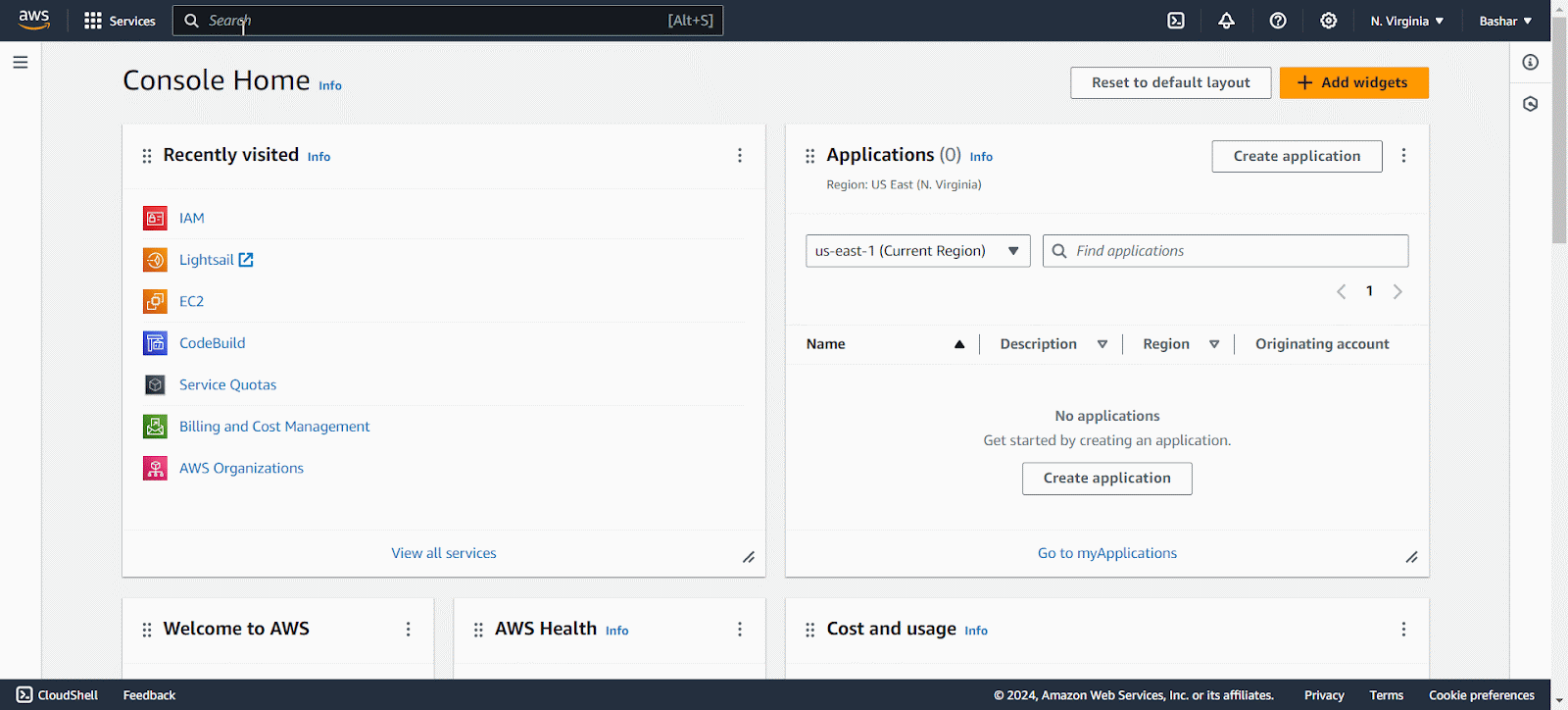
Step 5: Add a New User #
On the IAM dashboard, locate and click on the Users option in the left navigation panel. This will display a list of existing IAM users. To create a new user, click on the ‘Create User’ button.
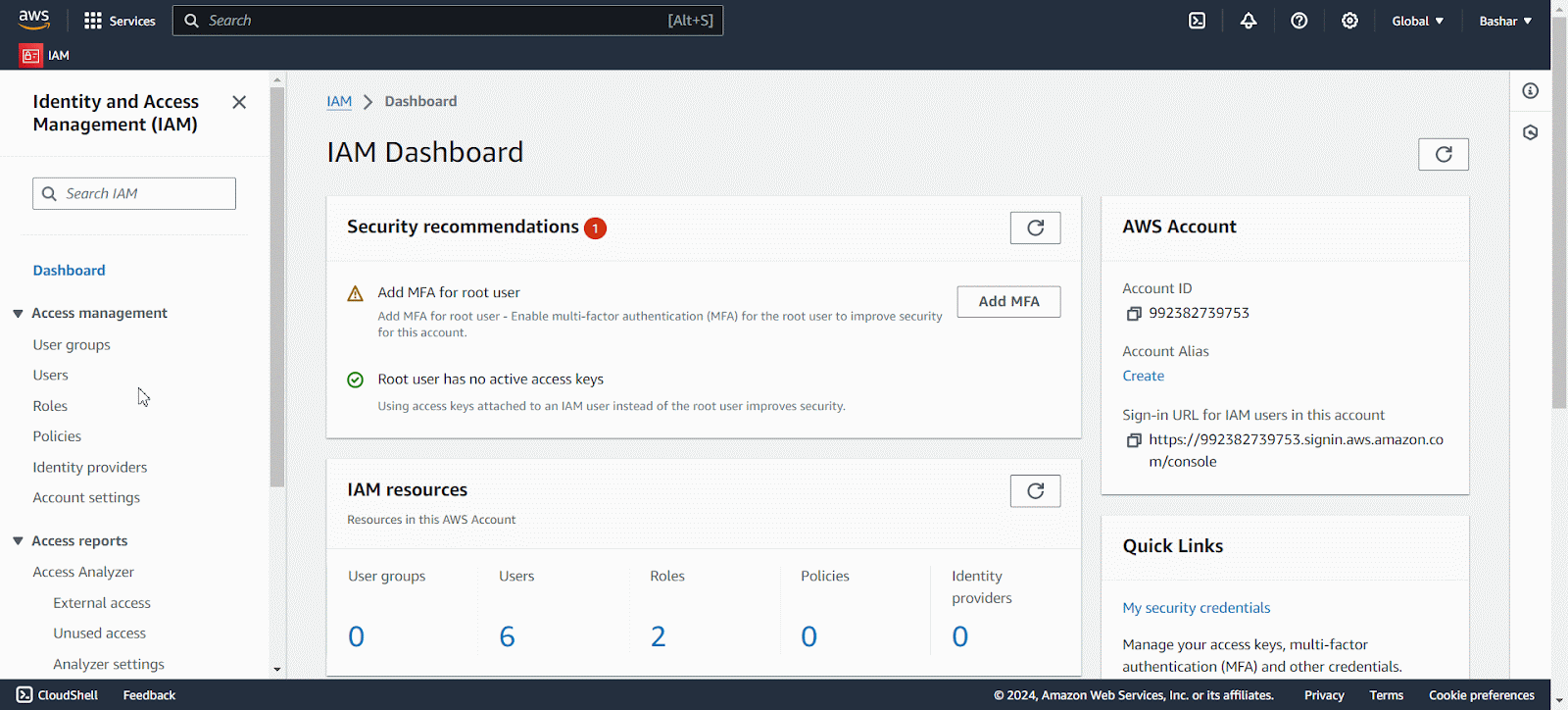
Step 6: Configure User Details #
In this step, enter a unique ‘Username’ for the new IAM user. Next, choose the type of access the user requires. Check-in ‘AWS Management Console’ access option if the user requires access to the AWS Management Console and click on the ‘Next’ button.
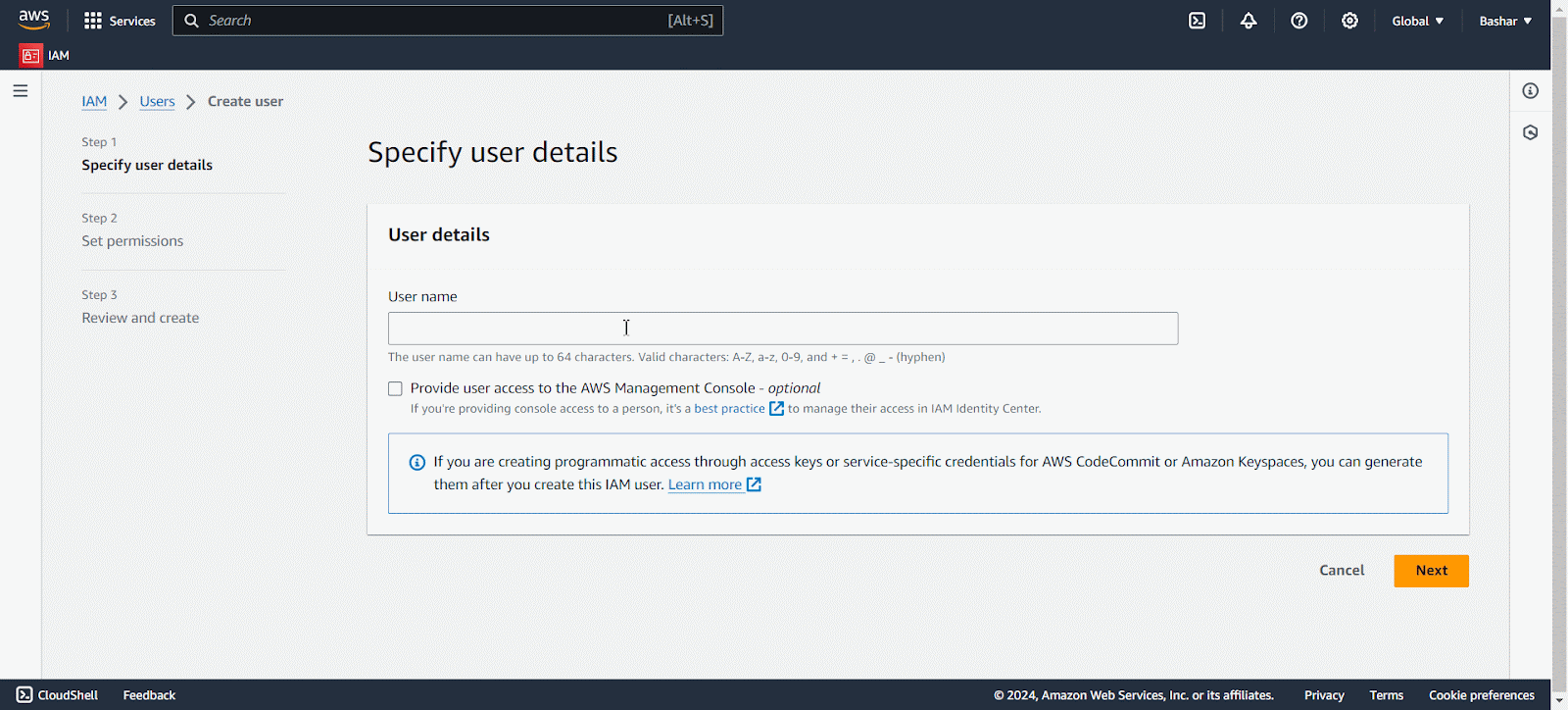
Step 7: Set Permissions for Amazon EC2 Instance #
You have three options to set permissions for the new user. The first one is ‘Add user to group’ which lets you add the user to an IAM group with predefined permissions, which is efficient for managing multiple users with similar access needs. The second one is ‘Copy permissions’ which enables you to duplicate the permissions of another IAM user. And the final policy ‘Attach policies directly’ allows you to assign AWS-managed policies or custom policies.
Here we are choosing the ‘Attach policies directly’ and assigning the access for Amazon EC2 Instance to the user and hit on the Next.
Note: If you do not find the EC2 Access here, search for the policy in the search bar.
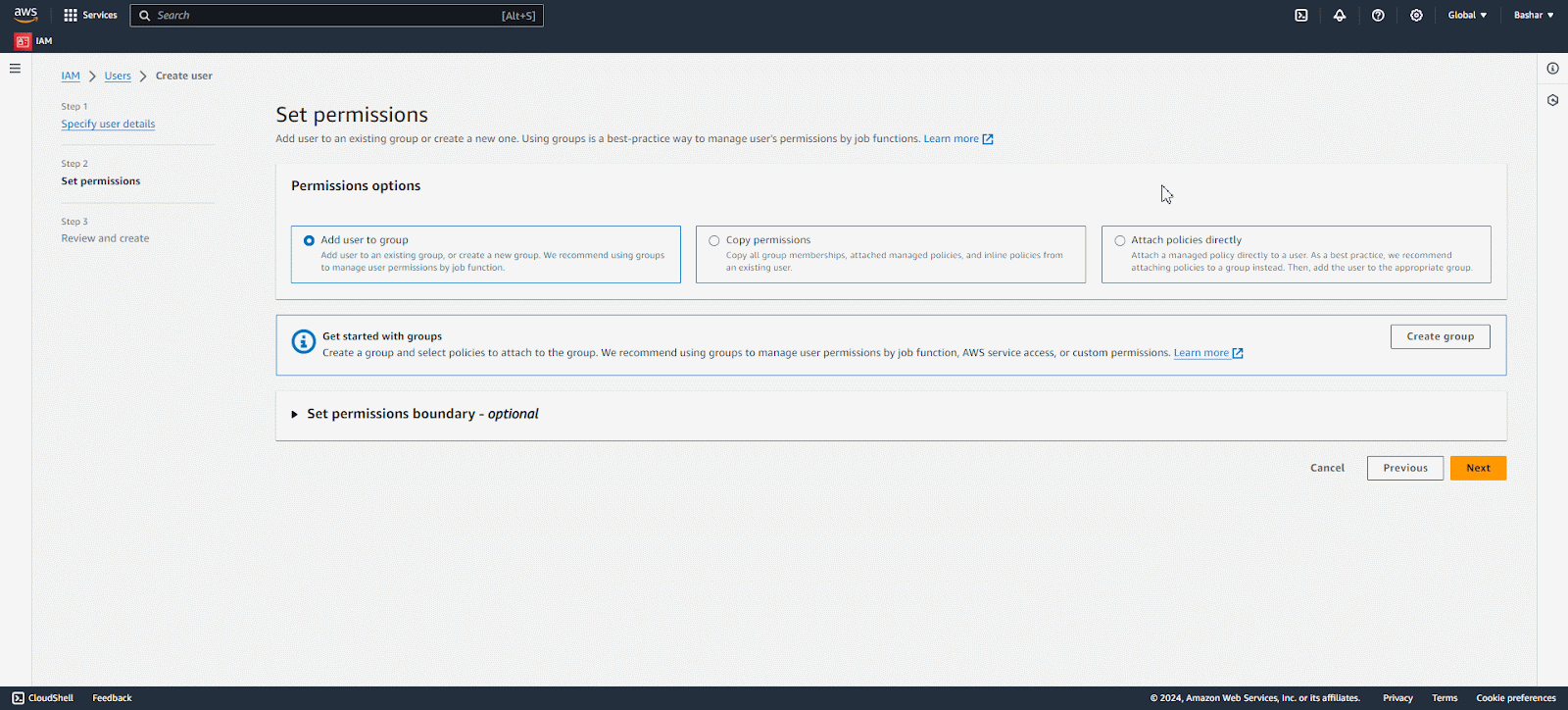
Step 8: Add Tags, Review and Create #
You can add ‘Tags’ to help organize and manage users. Now carefully review all the details and permissions assigned to the new IAM user. If everything is accurate and complete, click the ‘Create user’ button to finalize the creation of the IAM user.

Step 9: Give Another permission for Amazon Lightsail #
Now, set another permission for the new user for Amazon LightSail easily. To specify the permissions for the created user, go to the Permission Policies and click on the ‘Add Permissions Menu’. Choose the ‘Create Inline Policy’ option from the dropdown menu.
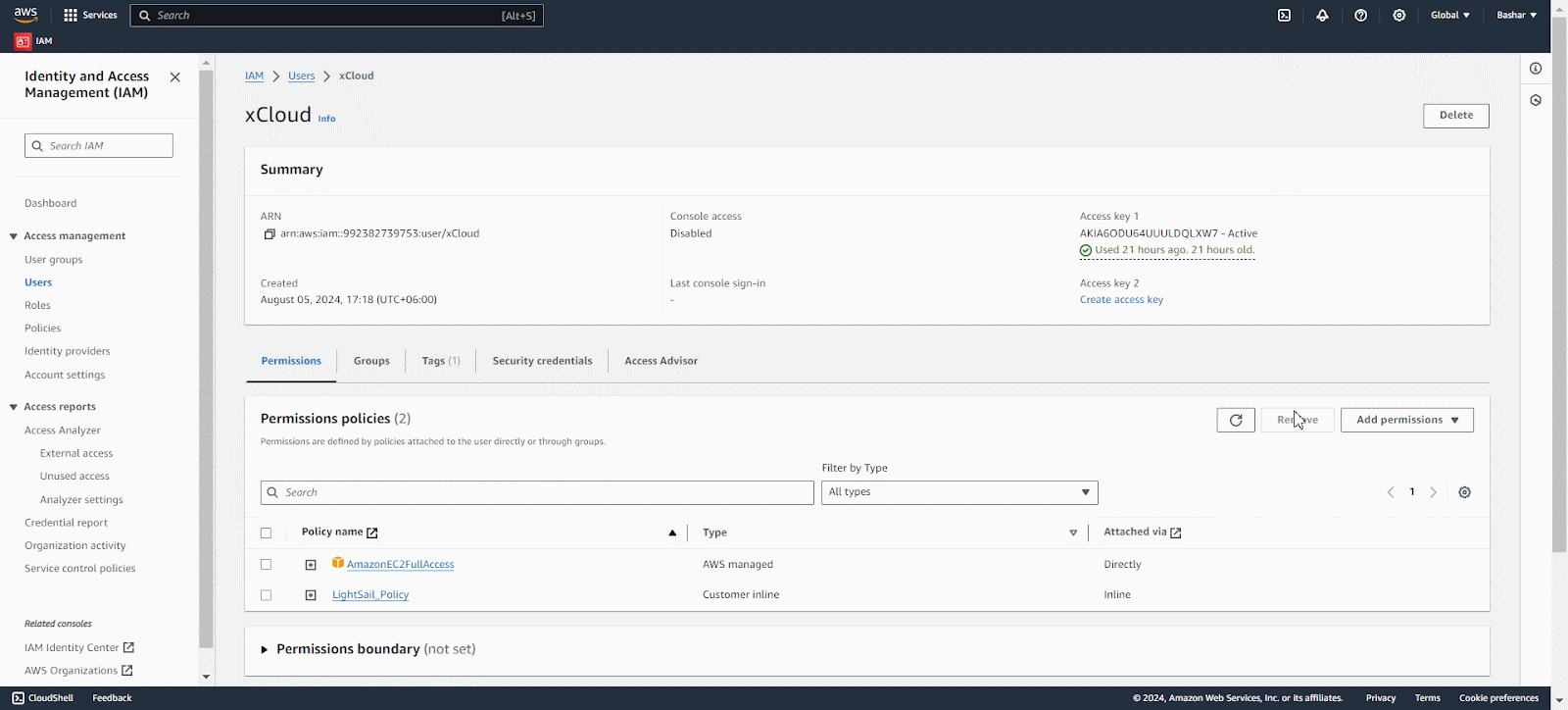
Click on the ‘JSON’ button from the Policy Editor and paste the below given JSON code in the editor. Finally, tap on the ‘Next’ button.
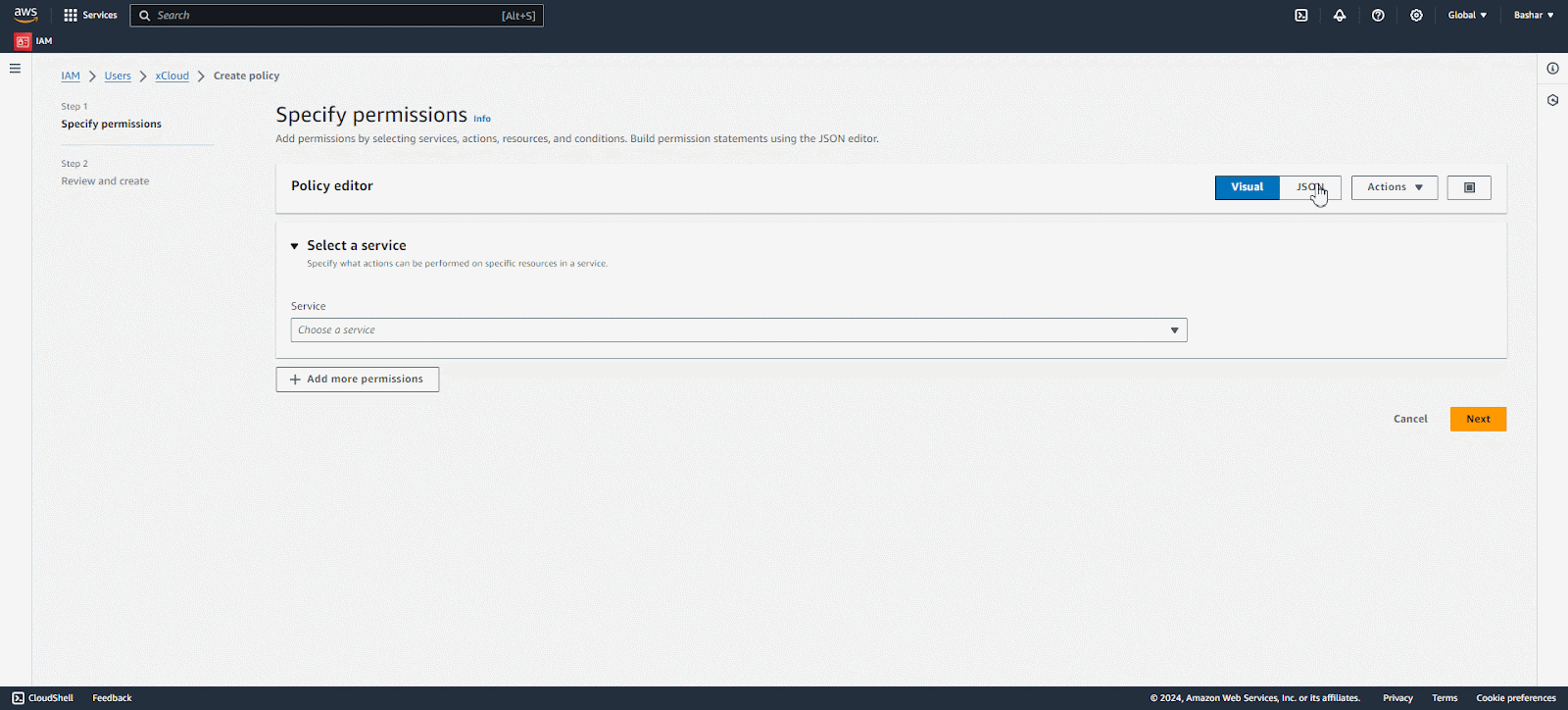
Here is the JSON code:
{
"Version": "2012-10-17",
"Statement": [
{
"Sid": "VisualEditor0",
"Effect": "Allow",
"Action": [
"lightsail:GetInstances",
"lightsail:GetKeyPair",
"lightsail:DeleteKeyPair",
"lightsail:GetStaticIp",
"lightsail:ReleaseStaticIp",
"lightsail:SetIpAddressType",
"lightsail:CreateInstances",
"lightsail:GetInstance",
"lightsail:GetInstanceAccessDetails",
"lightsail:DeleteInstance",
"lightsail:CreateKeyPair",
"lightsail:ImportKeyPair",
"lightsail:StartInstance",
"lightsail:DownloadDefaultKeyPair",
"lightsail:GetInstancePortStates",
"lightsail:StopInstance",
"lightsail:AttachStaticIp",
"lightsail:GetRegions",
"lightsail:RebootInstance",
"lightsail:GetOperation",
"lightsail:DetachStaticIp",
"lightsail:GetInstanceState",
"lightsail:GetBundles",
"lightsail:TagResource",
"lightsail:PutInstancePublicPorts"
],
"Resource": "*"
}
]
}
Once the policy is created for Lightsail instance, give the policy a name and hit on the ‘Create Policy’ button.
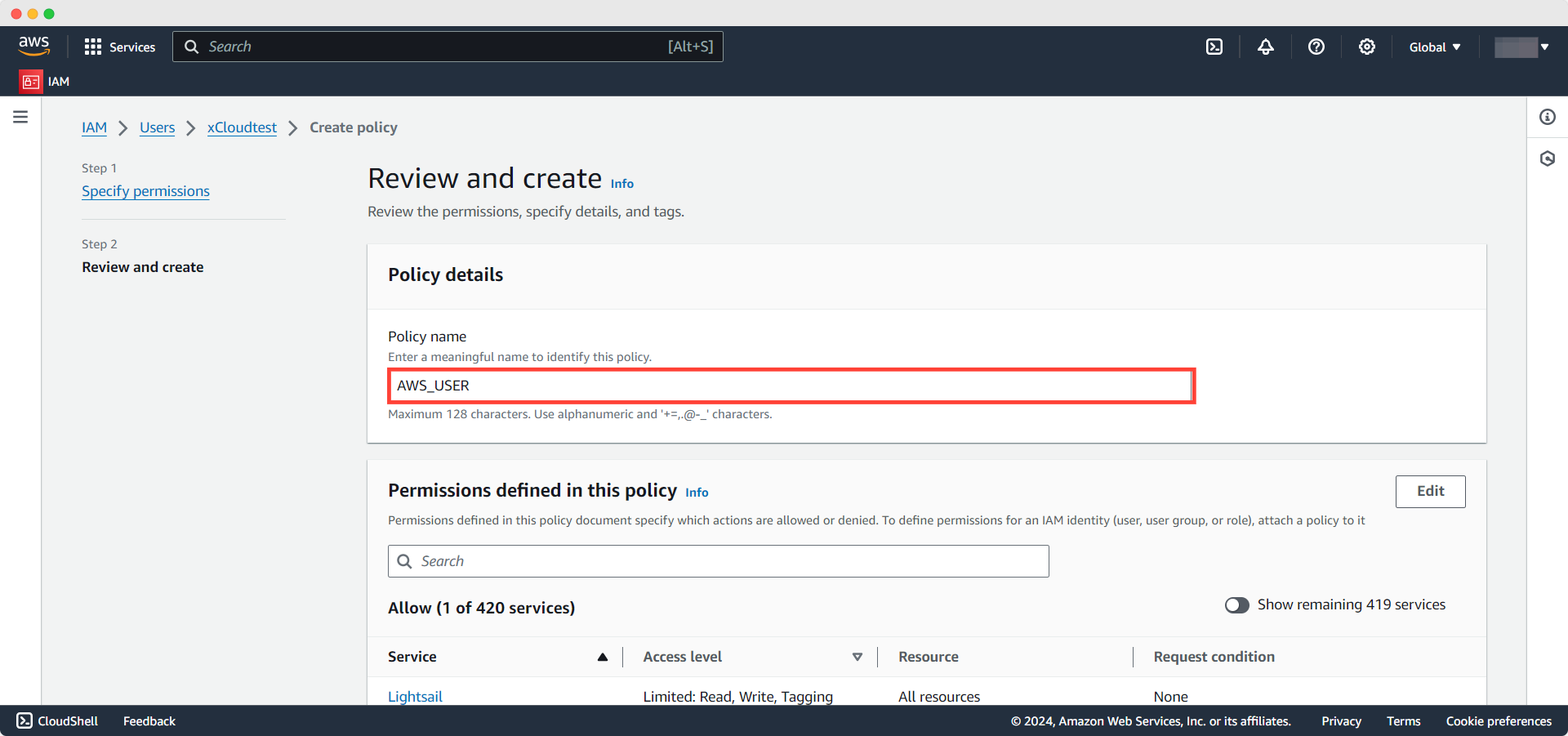
Step 10: Create & Retrieve a User Access Key #
Now we have to create a user access key. Find ‘Create access key’ under the Summary tab and click on it. Then you will be redirected to the Access Key best practices & Alternatives page, from here select the ‘Other’ option and click on Next.
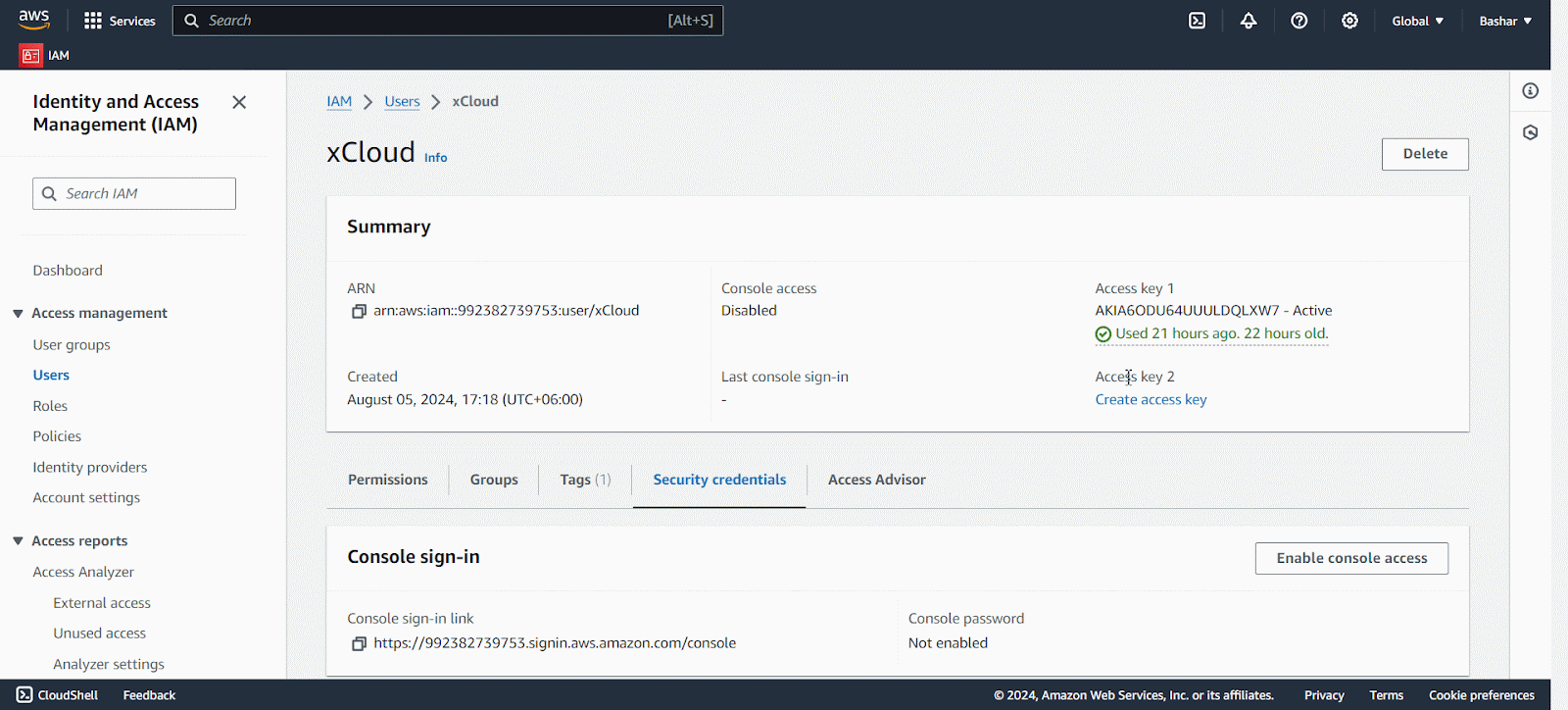
Now give a Description Tag to proceed to create an access key. Once the access key is created copy the Access Key and Secret from from here and go back to your xCloud Dashboard to integrate the server with xCloud.
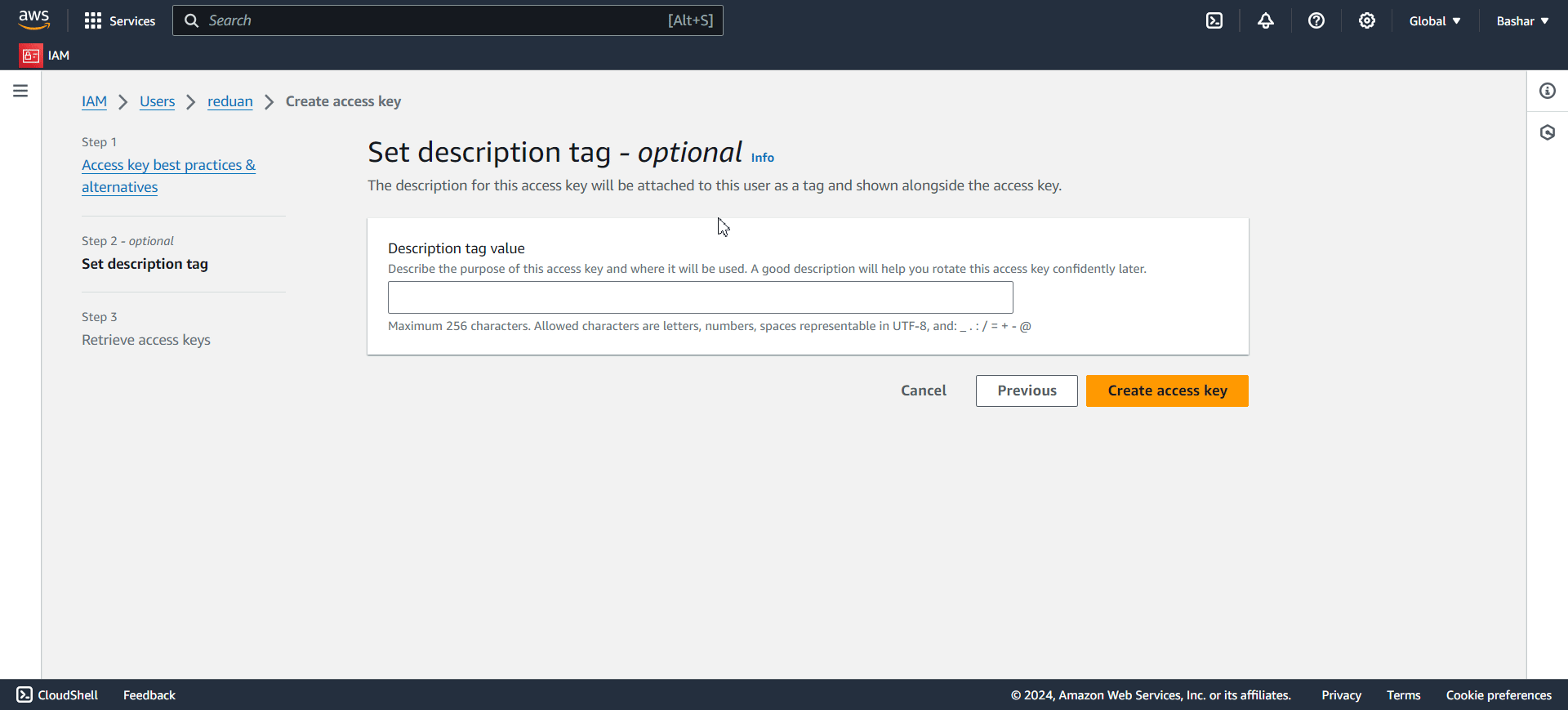
Step 11: Connect the Account & Add Necessary Information #
From the AWS dashboard, select an existing or connect new account from the dropdown menu. Then choose the AWS services, you can use any one with the proper credentials or both from the xCloud dashboard.
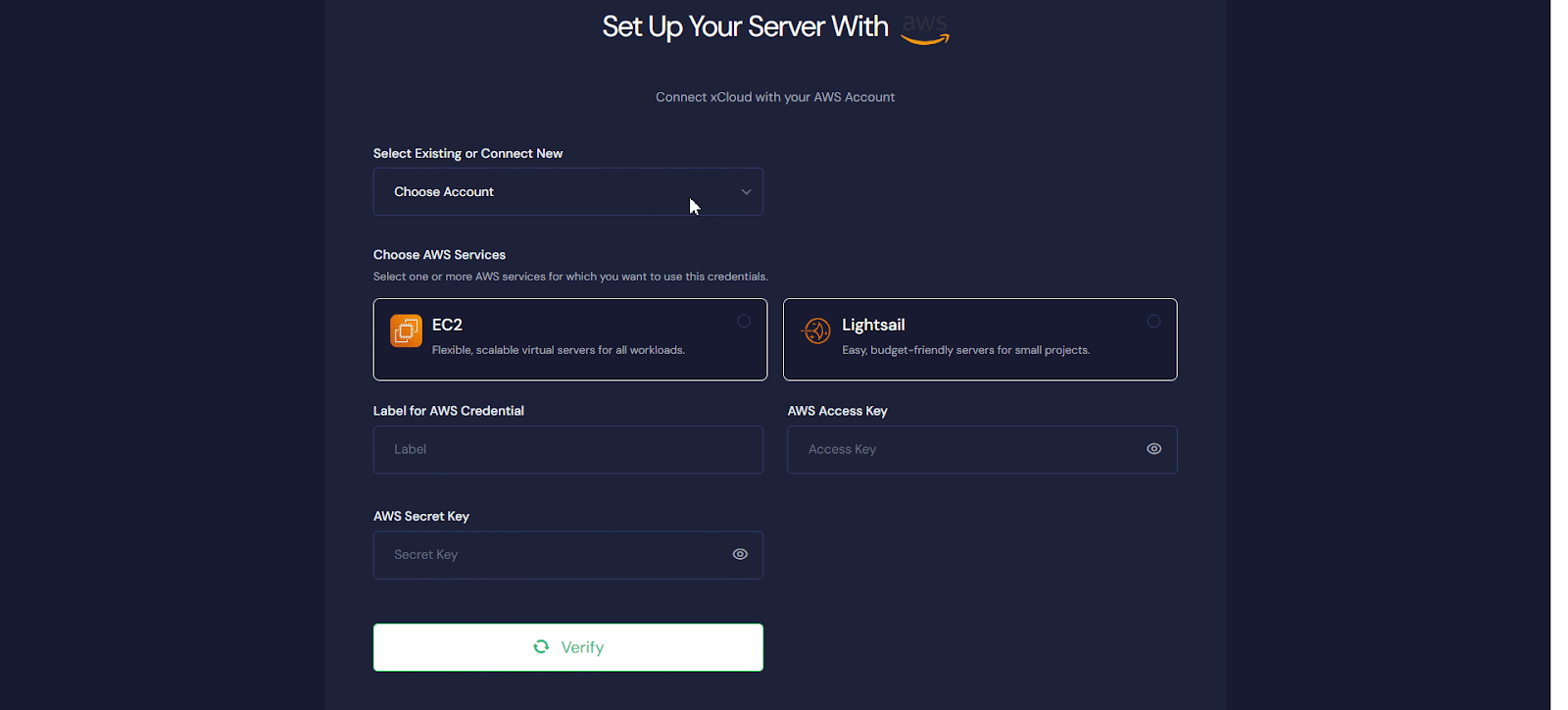
As you have the Access Key and Secret Key Paste them into the designated blank boxes one by one carefully. Now click on ‘Verify’ button, it will start verifying the credential and connect you with the AWS server.

Fill all the information like ‘Server Name’, ‘Server Region’, ‘Server Zone’,’Server Size’, etc according to your preference.

Next, choose the web server stack from NGINX or OLS as your requirements and click on ‘NEXT’ button to proceed with the server creation process.

It will start creating a AWS server with xCloud within a while and if you go to the ‘Servers’ from the menu you can see your created server and create as many site as you want under this server

This is how easily you can create an AWS server from xCloud seamlessly without going through any difficulties.
After creating your server with AWS, you would want to create your first site with xCloud. Follow this documentation to learn how to do that. You can also take a look at how to add xCloud managed email service for WordPress site emails.
Still stuck? Contact our support team for any of your queries.






